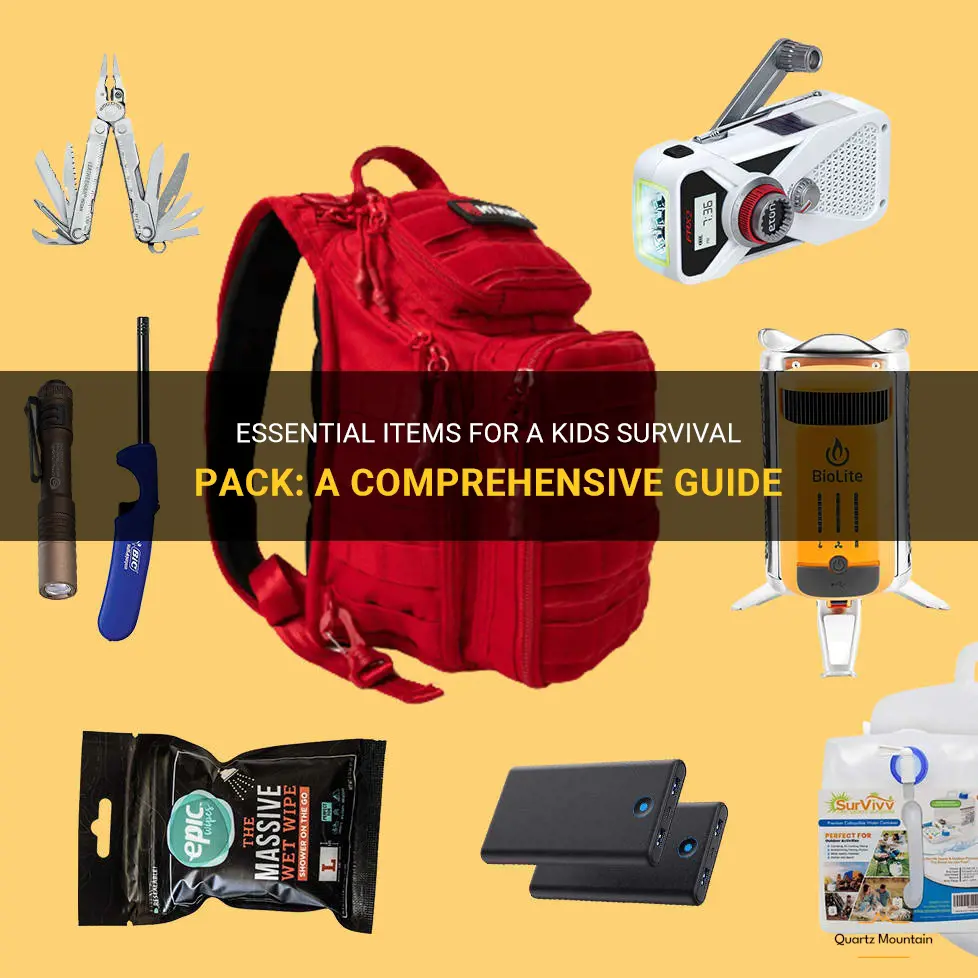
Picture this: you're deep in the wilderness, surrounded by towering trees, with only the sound of birds chirping and the wind rustling through the leaves. But wait, there's something different about this adventure - you're not alone. Alongside you is a budding explorer, equipped with their very own survival pack. In this comprehensive guide, we will explore and uncover the essential items every kid needs in their survival pack to ensure a safe and exciting wilderness experience. From maps and compasses to first aid kits and water purifiers, this guide will equip you with everything you need to know to prepare your little adventurer for any wild journey ahead. So, let's delve into the world of survival kits and discover the key essentials that will make every kid feel like a true explorer.
| Characteristics | Values |
|---|---|
| Food and Water | Non-perishable food, water bottles |
| First Aid Kit | Band-aids, gauze, antiseptic |
| Clothing | Extra clothes, raincoat, hat |
| Shelter | Emergency blanket, tarp |
| Light and Communication | Flashlight, whistle |
| Tools | Multi-tool, duct tape |
| Personal Hygiene | Toothbrush, toothpaste, soap |
| Entertainment | Coloring book, crayons |
| Identification | Emergency contact information |
| Cash | Small bills for emergencies |
| Important Documents | Copies of passports, medical records |
What You'll Learn
- What are the essential items that should be included in a kids survival pack?
- What food and water supplies are recommended for a kids survival pack?
- Are there any specific medical supplies that should be included in a kids survival pack?
- How can I ensure that the kids survival pack is lightweight and easy for children to carry?
- Are there any special considerations or items that should be included in a kids survival pack for different environments or weather conditions?

What are the essential items that should be included in a kids survival pack?
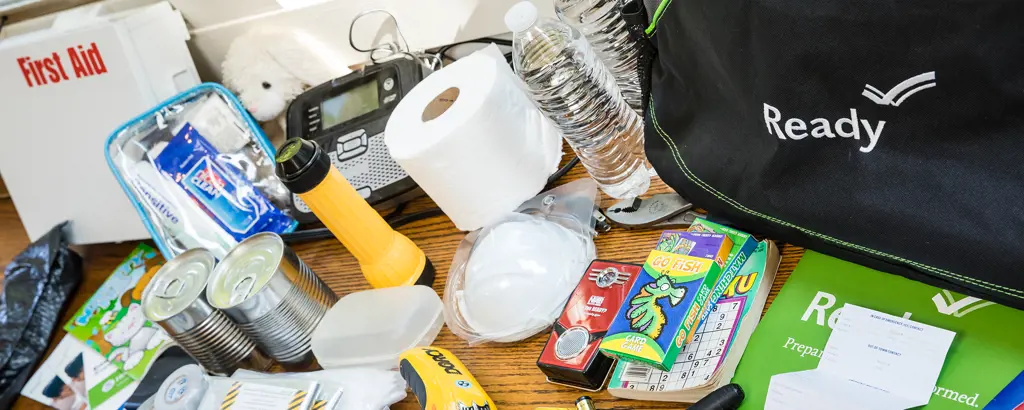
A kids survival pack is an essential item for any parent or caretaker to have on hand, especially in emergency situations. Whether you are planning a camping trip or want to be prepared for unforeseen events, having a well-stocked survival pack for kids can provide peace of mind and potentially save lives. Here are some essential items that should be included in a kids survival pack.
- Water: Water is essential for survival, and it is important to have enough for each child in the pack. The general rule of thumb is one gallon of water per person per day. Consider storing water in individual water pouches or lightweight water bottles to make it easier for kids to carry.
- Food: Pack non-perishable food items such as energy bars, granola bars, or dehydrated meals that can be easily prepared. Make sure to include enough food to last each child for at least three days.
- First aid kit: Accidents happen, and having a well-equipped first aid kit is crucial. Include items such as bandages, antiseptic wipes, tweezers, scissors, and any necessary medications.
- Emergency blanket: These compact, lightweight blankets are designed to retain body heat and can provide warmth in cold weather. Choose ones that are durable and waterproof to ensure they can withstand rough conditions.
- Whistle: A whistle can be a lifesaver in an emergency situation. Teach your children that blowing the whistle repeatedly can help them attract attention and potentially be rescued.
- Flashlight: Include a flashlight and extra batteries in the survival pack. Opt for a flashlight that is durable and waterproof, with a long battery life. Don't forget to teach your kids how to use it safely.
- Personal hygiene items: Include items such as wet wipes, hand sanitizer, toilet paper, and personal hygiene products. These items can help maintain cleanliness and prevent the spread of germs.
- Extra clothing: Pack extra clothing, including socks, underwear, and a waterproof jacket or poncho. This will help keep kids dry and warm, especially in inclement weather.
- Multi-tool: A multi-tool can come in handy in various situations. Look for ones that have a knife, screwdriver, can opener, and other essential tools. However, make sure to keep it out of reach of young children and educate older kids on its proper use.
- Emergency contact information: Include a list of emergency contact numbers, including parents' or guardians' phone numbers and addresses. It is also helpful to include phone numbers of other family members or close friends who can help in an emergency.
Remember, each child's survival pack should be tailored to their specific needs and age. Consider their size, abilities, and any special requirements they may have. Regularly check and update the items in the pack, ensuring that everything is in working order and not expired.
In conclusion, a kids survival pack should contain essential items such as water, food, a first aid kit, emergency blankets, a whistle, flashlight, personal hygiene items, extra clothing, a multi-tool, and emergency contact information. By being prepared with these items, you can help ensure the safety and well-being of children in emergency situations.
Essential Items to Pack for a Winter River Cruise in Europe
You may want to see also

What food and water supplies are recommended for a kids survival pack?
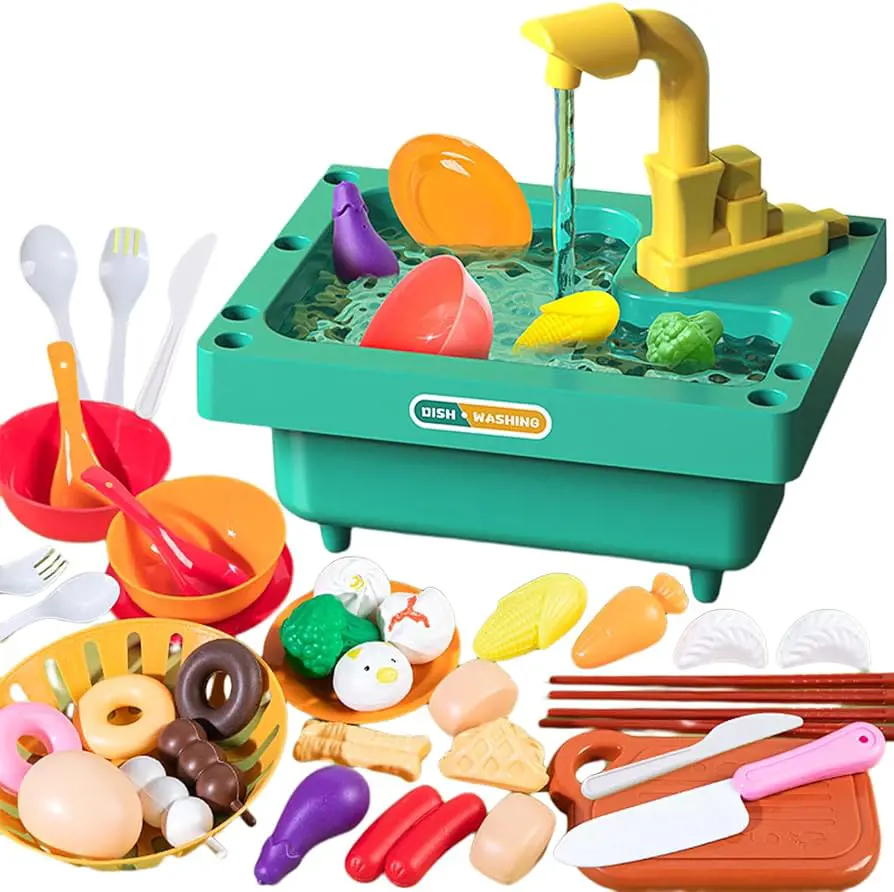
A kids survival pack is an essential item to have in case of emergencies or while exploring the great outdoors. This pack should contain essential supplies to keep a child nourished and hydrated. Food and water supplies in a kids survival pack should be selected carefully to ensure they are safe, sustainable, and easy to consume.
When it comes to food supplies, it is important to choose items that are non-perishable and can provide a good balance of nutrients. Some recommended food items for a kids survival pack include:
- Energy bars: These bars are typically high in calories and provide a quick source of energy. Look for bars that are specifically made for kids, as they often have smaller portions and flavors that appeal to children.
- Dried fruit: Dried fruits, such as raisins, apricots, and mangoes, are lightweight and packed with vitamins and minerals. They are a great source of natural sugars and can provide a quick energy boost.
- Nuts and seeds: Nuts and seeds are high in protein and healthy fats, making them an excellent choice for a survival pack. Choose varieties that are not heavily salted or flavored, as excess sodium can lead to dehydration.
- Crackers or rice cakes: These carbohydrate-rich snacks can provide a sense of fullness and energy. Opt for whole wheat or multi-grain varieties for added fiber.
- Peanut butter or nut butter packets: These single-serving packets are convenient and can be paired with crackers or bread. They are a good source of protein and healthy fats.
In addition to food supplies, water is a crucial component of any survival pack. It is recommended to include both water bottles and water purification methods to ensure a continuous supply of clean drinking water. Some options for water supplies include:
- Water bottles: Include a sturdy water bottle that can hold enough water for the duration of the trip or emergency. Look for bottles made from BPA-free materials and with a wide mouth for easy refilling.
- Water purification tablets: These tablets can be used to treat water from natural sources such as rivers or lakes. They work by killing harmful bacteria and viruses, making the water safe to drink. Follow the instructions on the packaging for proper usage.
- Water filtration system: A portable water filter can remove impurities and contaminants from water sources. Look for a filter that is specifically designed for outdoor use and can filter out bacteria and protozoa.
- Hydration pack: A hydration pack is a backpack with a built-in water reservoir and drinking tube. This allows for hands-free hydration while on the move. These are particularly useful for hiking or other outdoor activities.
It is important to regularly check and replenish the food and water supplies in a kids survival pack to ensure their freshness and effectiveness. Make sure to store the pack in a cool, dry place away from direct sunlight to avoid spoilage.
Overall, a well-planned kids survival pack should include a variety of non-perishable and nutrient-dense food items, as well as reliable water supplies. By being prepared and having the right supplies, children can stay nourished and hydrated during emergencies or outdoor adventures.
Common Items You Should Avoid Packing When Flying to the USA
You may want to see also

Are there any specific medical supplies that should be included in a kids survival pack?
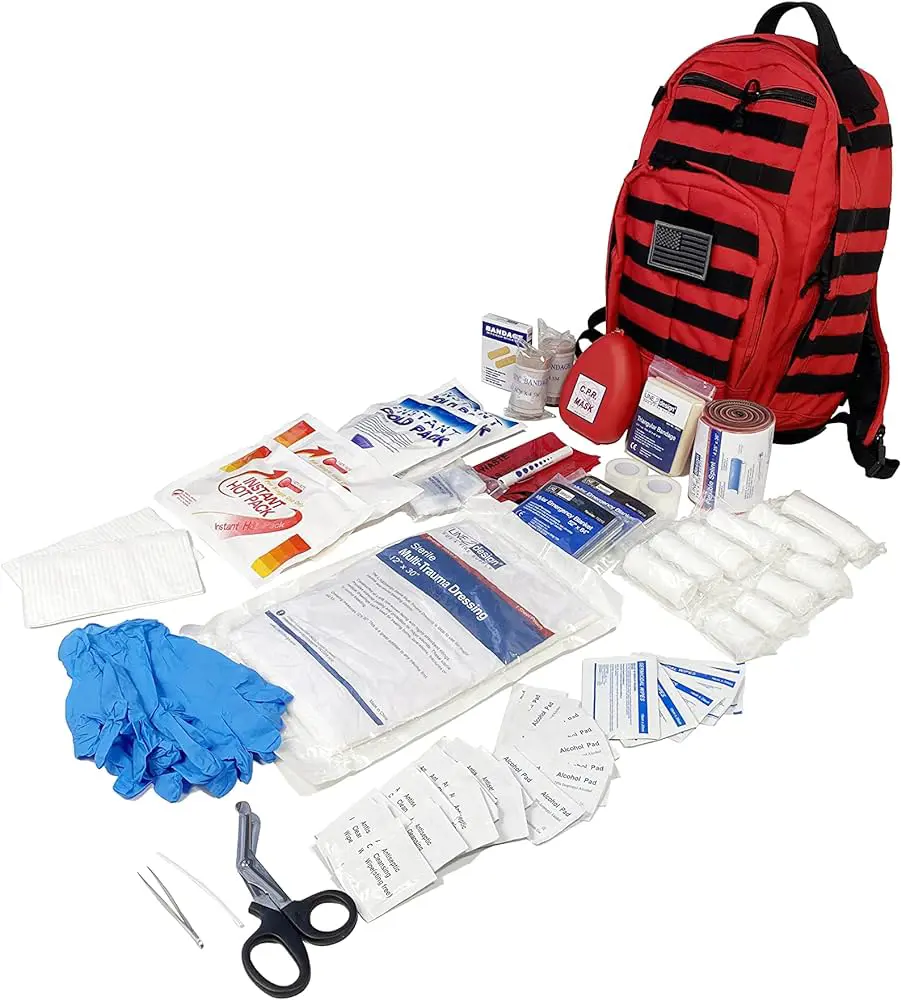
When preparing a survival pack for kids, it is important to consider their specific medical needs. Just like adults, children can get injured or become ill in an emergency situation. Including the right medical supplies in their survival pack can significantly help in providing immediate care.
Here are some specific medical supplies that should be included in a kids survival pack:
- Bandages and Adhesive Strips: These items are crucial for covering small cuts, scrapes, and blisters. Be sure to include a variety of sizes to accommodate different wound sizes.
- Antiseptic Wipes: Cleaning wounds is essential to prevent infection. Antiseptic wipes are convenient for cleaning and disinfecting minor cuts and abrasions.
- Antibiotic Ointment: After cleaning a wound, applying antibiotic ointment can help prevent infection. Look for an over-the-counter antibiotic ointment that is safe for children.
- Gauze Pads and Tape: For larger wounds or as a second layer over a bandage, gauze pads and tape can provide better protection and promote healing.
- Tweezers: Tweezers are useful for removing splinters or foreign objects from the skin. Opt for a pair with a pointed tip and make sure to disinfect them before and after use.
- Thermometer: Fever is a common symptom in illnesses. A digital thermometer is essential to monitor a child's body temperature and determine if medical attention is needed.
- Pain Relievers: Include children's pain relievers, such as acetaminophen or ibuprofen, in their survival pack. These can help alleviate pain and reduce fever until professional medical help is available.
- Allergy Medication: If your child has known allergies, include antihistamines specifically formulated for children. This can help manage allergic reactions in emergency situations.
- Inhaler or EpiPen: If your child has asthma or severe allergies, make sure their inhaler or EpiPen is easily accessible in their survival pack. These can be life-saving in critical situations.
- Prescription Medications: If your child takes any prescription medications, ensure you have a sufficient supply in their survival pack. Remember to rotate and replace them regularly to avoid expiration.
Remember, it is crucial to consult with your child's pediatrician before including any medication in their survival pack. They can provide guidance on appropriate dosage and specific needs based on your child's medical history.
In addition to these medical supplies, it is essential to include any necessary medical documents, such as copies of prescriptions, medical insurance cards, and emergency contact information. Teaching your child basic first aid skills can also be beneficial.
Lastly, familiarize yourself with how to use the medical supplies in your child's survival pack. Take a first aid course or consult a medical professional to ensure you are prepared to provide the necessary care in an emergency situation.
By including these specific medical supplies in your child's survival pack and being prepared, you can increase their chances of receiving immediate care and minimize the impact of injuries or illnesses during emergency situations.
The Essential Items to Pack for a February Trip to Las Vegas
You may want to see also

How can I ensure that the kids survival pack is lightweight and easy for children to carry?
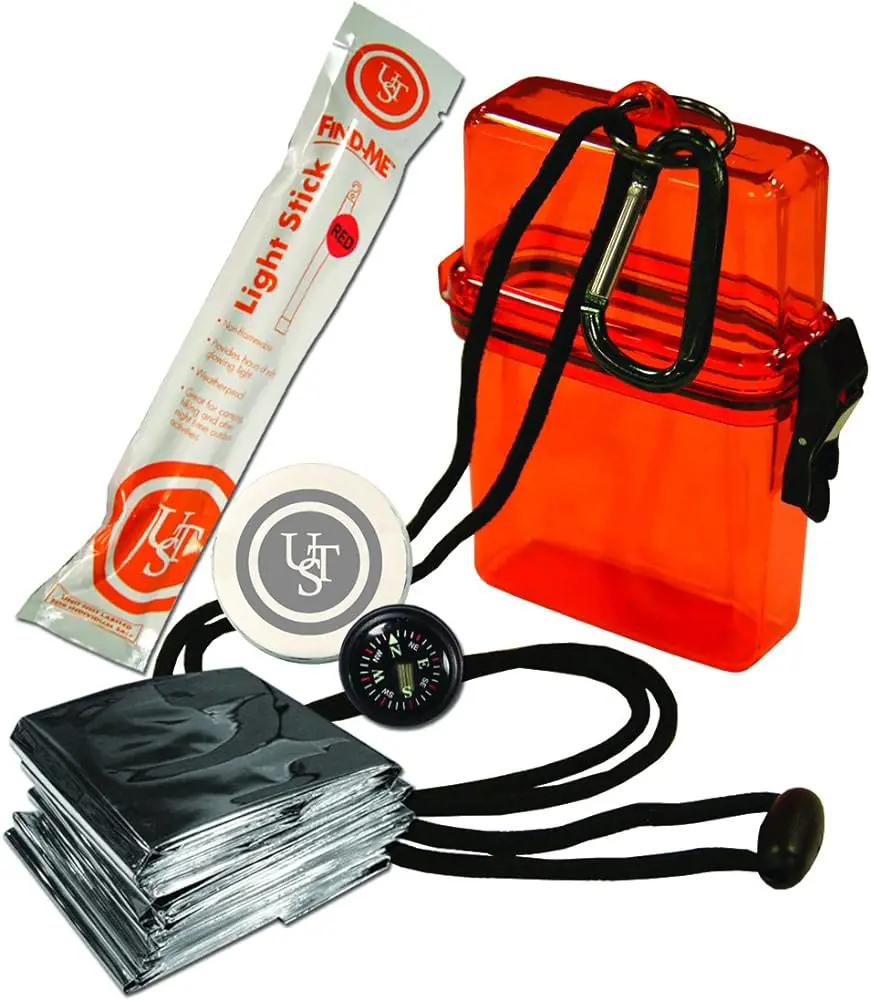
When creating a survival pack for children, it is important to consider its weight and ease of carry. Children may not have the strength or endurance to carry heavy backpacks long distances, so it is crucial to ensure that their survival pack is lightweight and easy for them to handle.
Here are some tips on how to make a kids survival pack that is lightweight and easy for children to carry:
- Start with the right backpack: Choose a lightweight backpack that is designed for children. Look for a pack that is made of durable materials but still lightweight. It should have adjustable straps to fit the child's body comfortably and distribute the weight evenly.
- Reduce unnecessary items: When packing a survival kit for children, it is essential to prioritize the most important items. Remove any unnecessary or bulky items that may add unnecessary weight. Focus on the essentials like food, water, a first aid kit, a flashlight, a whistle, and a multi-tool.
- Opt for lightweight alternatives: Instead of packing heavy canned food, choose lightweight, high-calorie energy bars or dehydrated meals. These are easy to carry and provide the necessary nutrients for survival. Also, lightweight water bottles or collapsible water bags can be used to carry water without adding much weight to the pack.
- Consider multipurpose items: Look for items that serve multiple purposes. For example, a bandana can be used as a head covering, a sling, or a water filter. A multi-tool can include various tools like a knife, can opener, and screwdriver, eliminating the need to carry separate items.
- Use compression sacks: Compression sacks can help reduce the overall size of the pack and make it easier to carry. These sacks allow you to compress items like clothing or a sleeping bag, reducing their volume and saving space in the backpack.
- Teach the child proper packing technique: It is crucial to teach children how to pack their survival pack effectively. Show them how to distribute the weight evenly and place heavier items closer to their back. This will help them carry the pack more comfortably and maintain their balance.
- Regularly review and update the pack: As children grow, their strength and abilities change. It is important to regularly review and update their survival pack to ensure it remains lightweight and suitable for their needs. Replace expired food and medications and adjust the contents as necessary.
By following these tips, you can create a kids survival pack that is lightweight and easy for children to carry. Remember to involve the child in the packing process and educate them on the importance of the items in their pack. With a well-planned and properly packed survival kit, children will be better prepared to handle emergencies and navigate challenging situations.
The Ultimate Guide to Packing for Excellence El Carmen Resort
You may want to see also

Are there any special considerations or items that should be included in a kids survival pack for different environments or weather conditions?
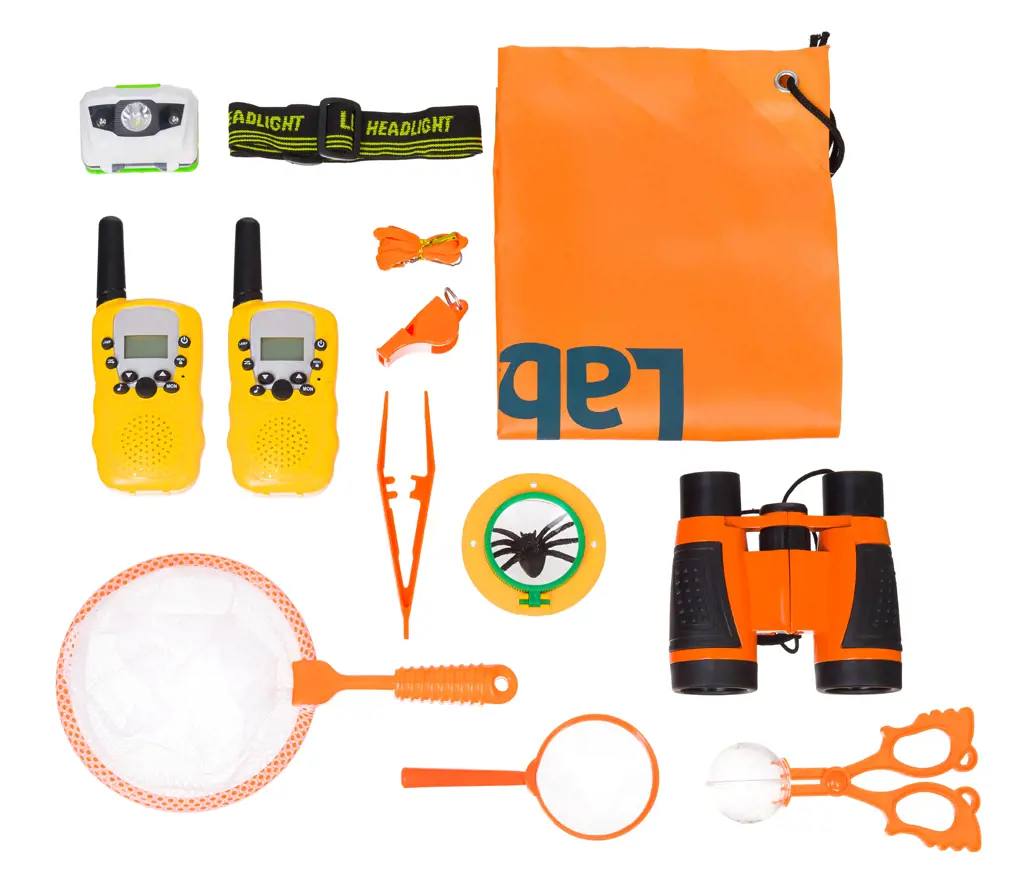
Kids can often find themselves in unexpected situations where having a survival pack specifically tailored to their needs can make a huge difference. Whether it's getting lost on a family hike or being stuck in severe weather conditions, it's essential to have a preparedness kit that addresses different environments and weather conditions. In this article, we will explore some special considerations and items that should be included in a kid's survival pack for different scenarios.
Hiking and Outdoor Adventures:
When going on a hike or any outdoor adventure, it's important to teach children the basic survival skills. A kid's survival pack should include a whistle for signaling and attracting attention, a compass for navigation, and a small flashlight with extra batteries. Additionally, pack a small first aid kit with band-aids, antiseptic wipes, and ointments to treat minor injuries.
Summer Survival Pack:
In hot weather conditions, it's crucial to protect children from dehydration and sunburn. Include a water bottle to ensure they stay hydrated, a hat to protect their head from the sun, sunscreen with a high SPF, and insect repellent to prevent bug bites. It's also wise to add a small handheld fan or misting bottle to help them cool down in extreme heat.
Winter Survival Pack:
In cold weather conditions, it's vital to keep children warm and protect them from hypothermia. Include extra layers of clothing such as hats, gloves, and thermal socks. Pack hand warmers or heat packs to keep their extremities warm. A small emergency blanket can provide insulation and additional warmth. It's also wise to include high-energy snacks like granola bars or trail mix to provide fuel and warmth for their bodies.
Severe Weather Preparedness:
In regions prone to severe weather events like hurricanes or tornadoes, a kid's survival pack should account for the potential loss of power and access to supplies. In addition to the basics like food, water, and a first aid kit, pack a battery-operated weather radio to stay informed about the situation. Include a whistle to signal for help, a waterproof container for important documents and medication, and a dust mask in case of dust or debris in the air. It's also essential to include comfort items like a stuffed animal or favorite toy to provide a sense of security during stressful times.
Waterproofing Considerations:
In any survival pack, it's crucial to protect the contents from water damage. Consider using waterproof containers or bags to keep items dry. Additionally, include a few heavy-duty plastic bags that can be used as makeshift ponchos or to protect valuable items from rain.
Remember, it's essential to involve children in the process of creating their survival pack. Educate them about the purpose of each item and how to use them appropriately. Regularly check and update the survival pack to ensure that items are in good working condition and that they are sized appropriately as the child grows.
In conclusion, a kid's survival pack should be tailored to the specific needs of different environments and weather conditions. By considering items such as navigation tools, protective gear, and comfort items, you can ensure that your child is prepared for unexpected situations. Taking the time to educate children on how to use each item can give them the necessary skills and confidence to stay safe.
Essential Items to Pack for a Winter Cruise
You may want to see also
Frequently asked questions
- A kids survival pack should include essential items such as a first aid kit with band-aids, antiseptic wipes, and other basic medical supplies. It should also contain non-perishable food items like granola bars or trail mix, a water bottle or water purification tablets, a flashlight with extra batteries, a whistle or signaling device, an emergency blanket or sleeping bag, a map, a compass, and a multi-tool or Swiss Army knife. These items will help ensure that a child is prepared for emergency situations and can take care of their basic needs.
- A good rule of thumb is to include enough food and water to last a child at least 72 hours. This means including 3 days' worth of non-perishable food items like granola bars or canned food, as well as a water bottle or water purification tablets that can provide enough water for drinking and basic hygiene needs. It is important to regularly check and update the supplies in the survival pack to ensure they are still safe to consume and use.
- For specific emergencies like earthquakes or hurricanes, there are a few additional items that can be included in a kids survival pack. These can include items such as a sturdy pair of shoes, a dust mask to filter out debris or smoke, a small whistle or bell to signal for help, and a small plush toy or comfort item to help alleviate fear and anxiety. It's also important to consider any specific needs that the child may have, such as medication or personal care items, and ensure that they are included in the pack as well.







